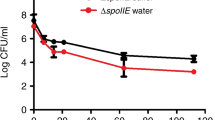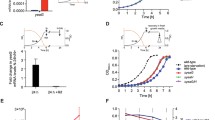Abstract
Non-differentiating bacteria adapt to starvation induced growth arrest by a complex turn-on/turn-off pattern of protein synthesis. This response shows distinct similarities with those of spore formation in differentiating organisms. A substantial amount of information on the non-growth biology of non-differentiating bacteria can be derived from studies onVibrio strains. One important result is that carbon rather than nitrogen or phosphorus starvation leads to the development of a starvation and stress resistant cell in these organisms. Hence, we have attempted to characterize the carbon starvation stimulon. By the use of two-dimensional gel electrophoresis of pulse-labelled cells and transposon mutagenesis, using reporter gene constructs, the identity and function of some members of the carbon starvation stimulon have been elucidated. Moreover, regulatory genes of the starvation response have been identified with these techniques. Current studies primarily address the identity and function of these genes. The role of transcript modification and stability for both long term persistence during starvation as well as the efficient recovery of cells which occurs upon nutrient addition is also addressed. It is suggested that an understanding of the functionality of the translational machinery is essential for the understanding of these adaptive pathways. This contribution also discusses the diversity of the differentiation-like response to starvation in different bacteria and whether a general starvation induced programme exists.
Similar content being viewed by others
References
Albertson NH, Nyström T & Kjelleberg S (1990a) Exoprotease activity of two marine bacteria during starvation. Appl. Environ. Microbiol. 56: 218–223
Albertson NH, Nyström T & Kjelleberg S (1990b) Functional mRNA half-lives in the marineVibrio sp. S14 during starvation and recovery. J. Gen. Microbiol. 136: 2195–2199
Albertson NH, Nyström T & Kjelleberg S (1990c) Macromolecular synthesis during recovery of the marineVibrio sp. S14 from starvation. J. Gen. Microbiol. 136: 2201–2207
Albertson NH, Nyström T & Kjelleberg S (1990d) Starvation-induced modulations in binding protein-dependent glucose transport by the marineVibrio sp. S14. FEMS Microbiol. Lett. 70: 205–210
Amy PS, Pauling C & Morita RY (1983) Recovery from nutrient starvation by a marineVibrio sp. Appl. Environ. Microbiol. 45: 1685–1690
Button DK, Schut F, Quang P, Martin R & Robertson BR (1993) Viability and isolation of typical marine oligobacteria by dilution culture: Theory, procedures and initial results. Appl. Environ. Microbiol. 59: 881–891
Chesbro W, Arbige, M & Eifert R (1990) When nutrient limitation places bacteria in the domains of slow growth: metabolic, morphologic and cell cycle behavior. FEMS Microbiol. Ecol. 74: 103–120
Davis BD, Luger SM & Tai PC (1986) Role of ribosome degradation in the death of starvedEscherichia coli cells. J. Bacteriol. 166: 439–445
Davis CL (1992) Production of laminarinase and alginase by marine bacteria after starvation. FEMS Microbiol. Ecol. 86: 349–356
Flärdh K, Cohen P & Kjelleberg S (1992) Ribosomes exist in large excess over the apparent demand for protein synthesis during starvation in marineVibrio sp. strain CCUG 15956. J. Bacteriol 174: 6780–6788
Geesey GG & Morita RY (1979) Capture of arginine at low concentrations by a marine psychrophilic bacterium. Appl. Environ. Microbiol. 38: 1092–1097
Hagström Å (1993) Succession and abundance of marine bacteria. In: Guerrero R & Pedrós-Ali`o C (Eds) Proceedings of the 6th International Symposium on Microbial Ecology. University of Barcelona Press
Herrero M, de Lorenzo V & Timmis KN (1990) Transposon vectors containing non-antibiotic resistance selection markers for cloning and stable chromosomal insertion of foreign genes in Gram-negative bacteria. J. Bacteriol. 172: 6557–6567
Holmquist L, Jouper-Jaan A, Weichart D, Nelson DR & Kjelleberg (1993) The induction of stress proteins in three marineVibrio during carbon starvation. FEMS Microbiol. Ecol. 12: 185–194
Holmquist L & Kjelleberg S (1993) Changes in viability, respiratory activity and morphology of the marineVibrio sp. strain S14 during starvation of individual nutrients and subsequent recovery. FEMS Microbiol. Ecol. (in press)
Jenkins DE, Auger EA & Matin A (1992) Role of RpoH, a heat shock regulator protein, inEscherichia coli carbon starvation protein synthesis and survival. J. Bacteriol. 173: 1992–1996
Jouper-Jaan Å, Goodman A & Kjelleberg S (1992) Bacteria starved for prolonged periods develop increased protection against lethal temperatures. FEMS Microbiol. Ecol. 101: 229–236
Kaplan R & Apirion D (1975) The fate of ribosomes inEscherichia coli cells starved for a carbon source. J. Biol. Chem. 250: 1854–1863
Kjelleberg S, Flärdh K, Nyström T & Moriarty DJW (1993) Growth limitation and starvation of bacteria. In: Ford TE (Ed) Aquatic Microbiology: An Ecological Approach (pp 289–320). Blackwell Scientific Publications, Boston
Kramer JG & Singleton FL (1992) Variations in rRNA content of marineVibrio spp. during starvation-survival and recovery. Appl. Environ. Microbiol. 58: 201–207.
Lange R & Hengge-Aronis R (1991) Identification of a central regulator of stationary phase gene expression inEscherichia coli. Mol. Microbiol. 5: 49–59
Mach H, Hecker M, Hill I, Schroeter A & Mach F (1989) Stringent control and starvation survival inEscherichia coli. Z. Naturforsch. 44c: 838–844
Malmerona-Friberg K, Goodman A & Kjelleberg S (1990) Chemotactic responses of a marineVibrio sp. strain S14 (CCUG 15956) to low-molecular-weight substances under starvation-survival conditions. Appl. Environ. Microbiol. 56: 3699–3704
Malmcrona-Friberg K, Tunlid A, Mårdén P, Kjelleberg S & Odham G (1986) Chemical changes in cell envelope and poly-bhydroxybutyrate during short term starvation of a marine bacterial isolate. Arch. of Microbiol. 144: 340–345
Mårdén P, Nyström T & Kjelleberg S (1987) Uptake of leucine by a marine Gram-negative heterotrophic bacterium during exposure to starvation conditions. FEMS Microbiol. Ecol. 45: 233–241
Matin A (1990) Molecular analysis of the starvation stress inEscherichia coli. FEMS Microbiol. Ecol. 72: 185–196
Matin A, Auger EA, Blum PH & Schultz JE (1989) Genetic basis of starvation survival in nondifferentiating bacteria. Ann. Rev. Microbiol. 43: 293–316
Molin S & Kjelleberg S (1993) Release of engineered microorganinsms: Biological containment and improved predictability for risk assessment. AMBIO, 22: 242–245
Neidhardt FC, Ingraham JI & Schaechter M (1990) Physiology of the Bacterial Cell. A Molecular Approach. Sinauer Associates Inc., Sunderland, USA
Nyström T, Albertson NH, Flärdh K & Kjelleberg S (1990a) Physiological and molecular adaptation to starvation by the marineVibrio sp. S14. FEMS Microbiol. Ecol. 74: 129–140
Nyström T, Flärdh K & Kjelleberg S (1990b) Responses to multiple-nutrient starvation in a marineVibrio sp. strain CCUG 15956. J. Bacteriol. 172: 7085–7097
Nyström T, Olsson RM & Kjelleberg S (1992) Survival, stress resistance and alterations in protein expression in the marineVibrio sp. S14 during starvation for different individual nutrients. Appl. Environ. Microbiol. 58: 55–65
Okamura S, Maruyama HB & Yanagita T (1973) Ribosome degradation and degradation products in starvedEscherichia coli. VI. Prolonged culture during glucose starvation. J. Biochem. 73: 915–922
Östling J, Goodman A & Kjelleberg S (1991) Behaviour of IncP-1 plasmids and a miniMu transposon in a marineVibrio sp.: isolation of starvation induciblelac operon fusions. FEMS Microbiol. Ecol. 86: 83–94
Östling J, Holmquist L, Flärdh K, Svenblad B, Jouper-Jaan Å & Kjelleberg S (1993) Starvation and recovery ofVibrio. In: Kjelleberg S (Ed) Starvation in Bacteria. (pp 103–128). Plenum Press, New York
Painting SJ, Lucas MI & Muir DG (1989) Fluctuations in heterotrophic bacterial community structure, activity and production in response to development and decay of phytoplankton in a microcosm. Mar. Ecol. Prog. Ser. 53: 129–141
Reeve CA, Bockman AT & Matin A (1984) Role of protein degradation in the survival of carbon-starvedEscherichia coli andSalmonella typhimurium. J. Bacteriol. 157: 758–763
Spence J, Cegielska A & Georgopoulos C (1990) Role ofEscherichia coli heat shock proteins DnaK and HtpG (C62,5) in response to nutritional deprivation. J. Bacteriol. 172: 7157–7166
Torella F & Morita RY (1983) Microcultural study of bacterial size changes and microcolony and ultramicrocolony formation by heterotrophic bacteria in seawater. Appl. Environ. Microbiol. 41: 518–527
Author information
Authors and Affiliations
Rights and permissions
About this article
Cite this article
Kjelleberg, S., Albertson, N., Flärdh, K. et al. How do non-differentiating bacteria adapt to starvation?. Antonie van Leeuwenhoek 63, 333–341 (1993). https://doi.org/10.1007/BF00871228
Issue Date:
DOI: https://doi.org/10.1007/BF00871228




